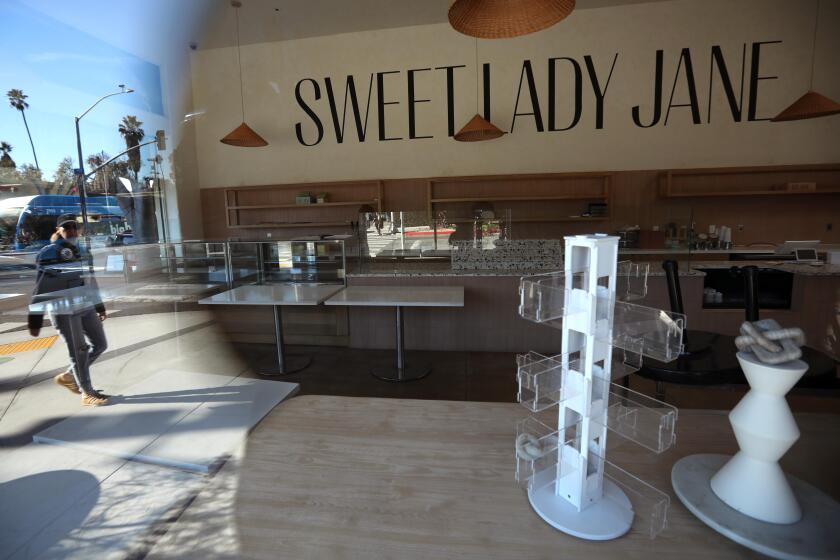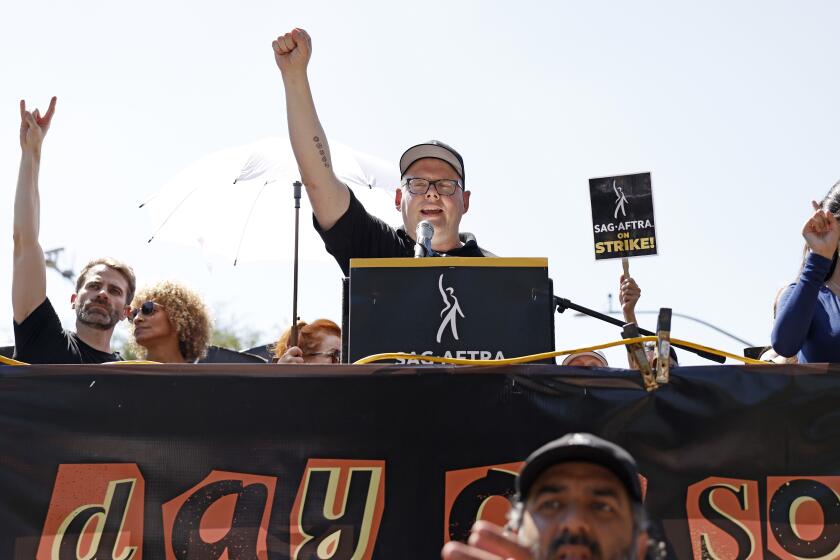He Cashes In on the Craze : Telephone Auctions Have Made Rosen a Mint
Alan Rosen is making money! And when Rosen, a.k.a. Mr. Mint, is making money he is ecstatic, baby, because he’s no big intellect, no big financial genius, and hoooooweeeee! people around the country--millionaires, no less!--are calling him to bid thousands of sweet, sweet dollars on hundreds of sports trinkets in Rosen’s memorabilia telephone auction.
On a foggy early April evening, hundreds of thousands of dollars’ worth of sports memorabilia sits on display in the front room of Rosen’s New Jersey storefront. His stock of new baseballs and Mr. Mint T-shirts is stored in a closet.
In the back room, the bearded, balding Mint Man sits beneath a fluorescent light’s glare, watching his operators--six friends, actually--record bids by hand on a tote board.
So much valuable stuff here, Mr. Mint. What do you personally collect?
“I collect money,” he says. “Hundred-dollar bills.”
He’s got a wad of $100s folded in the pocket of his stained sweat pants and says he has another $50,000 in a canvas bank bag, and $51,000 in his black briefcase, the fabled leather attache he schleps to card shows, hotel rooms and private homes, to pay anyone with the vintage cards, autographed balls, uniforms and press pins that ignite Rosen’s mint-condition cash-green fancy.
“I’m loud, I’m a braggart and I’m brash,” he proclaims. “But I’m the best. Last year I did $5.8 million in business, declared $740,000 in income and paid $180,000 in taxes. I declare 99.7% of my income. I don’t cheat. There’s no reason to. I pay for a car in cash. Cash!”
Rosen’s office walls are crammed with framed autographed photos of ballplayers such as Sandy Koufax, Don Drysdale, Joe Garagiola and Pete Rose. There’s another with Joe Pepitone and Rosen wearing the cowboy hat Pepitone wore when he was arrested for drug possession. Rosen owns the hat.
At all his auctions--this is his 11th--Rosen sells his and others’ goods. Eighty-nine of the 200 lots in this auction belong to Rosen, so he keeps that cash. The other stuff is on consignment, for which he gets a 10% commission.
Lot No. 1 is Mr. Mint’s baby, a rare 1912 set of 18 pictures of ballplayers such as Ty Cobb and Nap Lajoie on oddly shaped pieces of leather issued as Turkey Red tobacco premiums. Two years ago, a leading price guide said a full set of 25 was worth $16,000. Bidding on Mr. Mint’s incomplete set starts at $50,000. He thinks he’ll get $70,000. Then he can get his black Jaguar!
A $60,000 leathers bid sits like a lump through most of the evening.
But the bidding for other items soars. A letter from Kenesaw Mountain Landis, baseball’s first commissioner, soars to $850. Autographed bat, ball and print of the 500 home run club climb to $2,970, a Babe Ruth autographed ball to $2,000, Mickey Mantle’s high school yearbook to $1,100 and 19 World Series press pins from the 1940s to $14,700.
Rosen picks up a phone line and launches into a bid-schmooze: “Hey, it’s God on the phone.”
“God” is Barry Halper, a major collector.
“What do you want these for? Oh, you’re a piece of work. . . . It’s beautiful, absolutely beautiful, a gem, the best. . . . A beautiful Ruth autographed photo. . . . For less than you think.”
Mr. Mint is waiting for the leathers to shoot up. He knows they will. They’re so, so, valuable, so . . . Mintesque! His big guns, his millionaires--one is Jim Copeland, who owns Copeland Sporting Goods, and the other is Hub Finkelstein, a Houston oilman--will call any minute. He guarantees it.
“At 11:30, it becomes ‘Loony Tunes’ here,” he vows.
The phone lines light up four, five, six at a time. Six Mint apostles vie to pick up each incoming line. Rosen’s wife, Marnee, and one apostle wipe off old bids and post new ones.
“If anybody wants Lot 1,” Rosen says, “it’s mine.”
At 11:25, L.A. Sport, Copeland, calls.
“No. 1 to $63,000!” Rosen shouts. “Two more bids for my Jag!”
The action heats up. A 1949 Bowman card set goes for $8,925. Joe Cronin’s Boston Red Sox uniform for $3,765. A 1952 Casey Stengel uniform for $6,300.
At 11:48, Texas Oil, Finkelstein, calls. Rosen yaks away: “It’s the largest lot of leathers in the country. It was Bill Mastro’s when he was a lad.”
“Seventy-one thousand dollars! Yes! Yes!”
Ten minutes go by. A lot of Robin Yount cards goes for $2,300, a single pack of 1952 Topps cards for $1,575.
At 11:58, Mint is on the phone to L.A. Sport: “I got a problem. I got (Texas) on the other phone. The next bid would be $74,500.”
L.A. Sport goes to $74,500. Texas Oil quickly bumps it to $78,275.
At 11:59, Rosen coos about the leathers to L.A. Sport: “The Cobb has lines in it, but it’s as smooth as a baby’s . . . , like the Speaker.”
Seconds before midnight, L.A. Sport raises to $81,000.
“Alan, it’s midnight,” says Marnee Rosen. “The auction’s over.”
Rosen punches the line to tell L.A. Sport: “You own it.”
Texas Oil calls in a dither, wanting to raise the bid once more.
“No,” says Rosen, “I can’t take the bid. It’s after midnight. Right now! It’s over.”
And the cash keeps coming. On top of the $452,000 auction take, Rosen sells two more lots privately for $48,000. Not as good as his previous $513,000 auction a few months earlier but not bad, either. Certainly not bad for a self-professed “schmo” who just got by in his other businesses.
Tomorrow, express companies will deliver envelopes with checks and he’ll send out the goods. Says the Mint Man, with the confidence of one who has found his calling: “It’s a continuous legal laundering of cash.” And he smiles.
An orgy of collectibles--perhaps more vintage cardboard, horsehide, ash, rubber, flannel, leather, paper, canvas and double-knit assembled in one place than ever before--resides behind locked glass display cases on the vast floor of a West Side Manhattan pier.
The full bounty is up for sale in late April at the Guernsey’s auction house, which made a name for itself in memorabilia last year with a high-profile sale of original Topps baseball card artwork.
This, Guernsey’s claims, is the biggest sports memorabilia auction ever.
So you want Lou Gehrig’s retired uniform number? It’s here. So are Bob Cousy’s Holy Cross uniform, Shoeless Joe Jackson’s bat, full sets of Cracker Jack card sets from 1914 and 1915, Paul Blair’s 1970 World Series ring, Gil Hodges’ 1969 Mets’ warmup jacket, Joe Louis’ gloves and boxing licenses, two Muhammad Ali water bottles and the earliest-known bobbing-head doll.
The crowd here is like a ballpark’s: casual folks, mostly men, some families with young kids, clad in jeans and pullover shirts.
Chicago collector Mike Gidwitz says he has $400,000 to spend. He wants those press pins badly.
A quiet Texan rumored to be worth $100 million studies his catalogue.
Miamian Mark Friedland is here for himself and other bidders. His bids bespeak healthy backing, but he won’t say how much. For the right price, he wants a signed Gehrig bat.
“Sports auctions are like a trigonometric sine curve,” says Friedland, his hand moving in a wavy line. “You never know what will happen next.”
An autographed photo of Babe Ruth and Gehrig’s barnstorming teams sells for $10,450, artwork for Gil MacDougald’s 1952 Bowman rookie card for $1,870, a portrait of Walter Johnson for $6,050, a ball signed by Pete Rose and the late Bart Giamatti for $3,300 and a game-used, signed Mickey Mantle bat for $6,050.
New York dealer-auctioneer Joshua Evans is amazed at some of the low prices.
“I sold a Mantle unsigned bat for $4,000,” he moans. “For 6,000, he got a bargain. It should have gone for $10,000.”
Now up for bid is a dark brown bat signed and given to an 11-year-old by Lou Gehrig in 1938, his last full season. The boy, now in his 60s, consigned it to Guernsey’s. Auctioneer Joanne Grant, behind a raised platform, opens bidding, which starts at $5,000. It finally goes to Friedland, for $26,000.
Friedland says the bat is “aesthetically and abstractly important. The timing is important. It was given by a dying man to a child the year before he retired. It shows the circular nature of our existence.”
A pin made only for Gehrig and presented to him at the 1939 World Series two months after his retirement, is at bat. It is a one-of-a-kind piece, shaped like a baseball diamond, with diamonds at the bases. Gehrig gave it to the woman who cared for him as he was dying, and she gave it to her nephew.
Evans wants it. He goes to $27,000, then $33,000, $35,000 and $37,000. He owned it once, paying $7,000 for it two years ago, and sold it for $20,000.
In the cyclical nature of high-priced collectibles, dealers buy, sell, and reacquire items they owned before. But Evans is outbid at $41,800 by a young collector from Darien Conn., Daniel Lovegrove.
“It’s the greatest recollectic in the history of the Yankees and Gehrig is the best,” he says. “No one can ever touch him. Not Mattingly. Nobody.”
Evans, curious about Lovegrove, asks, “Who is that guy? What does he do? Is he a dealer?”
When told, he says purposefully: “I gotta talk to him.”
The big moment of the two-day auction is the sale of Bill Mastro’s pin collection, which is within one--the 1918 Boston Red Sox World Series pin--of a full set. But it’s more nearly complete than any other collection in this blazing-hot sector of the memorabilia market. Guernsey’s prices it at $400,000 to $500,000. Hardly anybody thinks Mastro will get it.
“I’ve put several hundred thousand into this,” says Mastro, of Palos Park, Ill. “If I don’t get near $300,000, I won’t make any money on it.”
Bidding starts at $200,000, but halts at Gidwitz’s $240,000 bid. That’s below the minimum price Mastro will sell it for, so if nobody bids higher, Mastro will go home with his pins.
“Do you want to know the minimum price?” auctioneer Arlan Ettinger asks Gidwitz, who knows he can make a profit on a resale, but wouldn’t mind keeping them for his own multimillion-dollar cache of collectibles.
“I’m not going to bid against myself, sir,” says Gidwitz. “I can talk to him afterwards. I know he has it. He knows I have the money. We can go to dinner later and talk about it.”
After the auction, Mastro sells for $275,000--but not to Gidwitz.
Baseball isn’t the only sport featured in the two-day auction, but it is clearly the one with the greatest interest. Ruth, Gehrig and their brethren remain the da Vinci and Picasso of the sports memorabilia market.
“If I said you could get a photo of Lincoln and Washington doing something together in the Oval Office, it’s virtually the same as having Ruth and Gehrig together,” says Friedland, acknowledging the cockeyed logic in his analogy. “You just have to keep things in perspective.”
More to Read
Inside the business of entertainment
The Wide Shot brings you news, analysis and insights on everything from streaming wars to production — and what it all means for the future.
You may occasionally receive promotional content from the Los Angeles Times.






